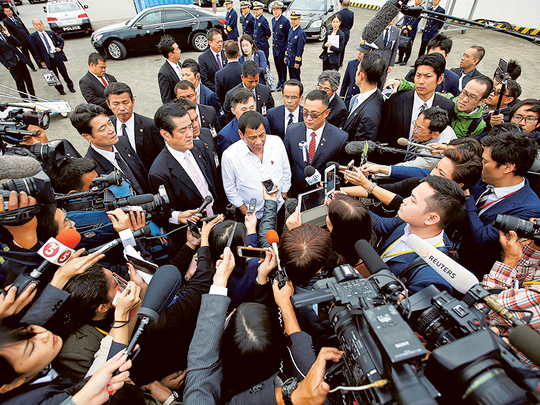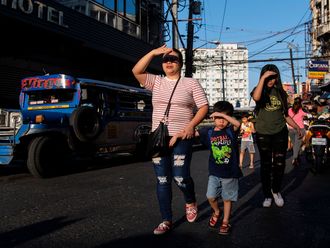
Manila: Japanese Prime Minister Shinzo Abe and Philippine President Rodrigo Duterte vowed to strengthen their countries’ strategic partnership but skipped forging a Visiting Forces Agreement (VFA) that would allow joint war games of their armed forces.
“With the aim of sustaining a peaceful and active relationship between the East Asian and Southeast Asian regions, the two leaders re-affirmed that the two countries fully commit to further strengthening the Strategic Partnership,” they said in a joint statement.
Abe and former Philippine president Benigno Aquino signed the “Strengthened Strategic Partnership of Japan and the Philippines” in Tokyo in June 2015. At the time, Aquino said it should be followed with the forging of Japan-Philippines VFA.
It was a logical conclusion after Japan’s legislature amended the constitution in 2014, to allow the 50,000-strong Japan Maritime Self Defence Force (JMSDF) to defend beleaguered allied countries and join overseas war games.
With 154 ships and 346 aircraft, JMSDF remained since 2014 a domestic peacekeeper after the United States had called for the Imperial Japanese Navy’s dissolution following its defeat in the Second World War.
The US-Philippines VFA was signed in 1998, and ratified by Philippine Congress in 1999. The Australia-Philippines VFA was signed in 2007, and ratified in 2012. The VFAs serve as guidelines to large-scale joint war-games.
Giving his view on VFA, Duterte said in an economic forum ahead of a meeting with Abe, “I want, maybe in the next two years, my country free of the presence of foreign military troops. I want them out and if I have to revise or abrogate agreements, executive agreements, I will.”
Abe and Duterte also witnessed the signing of the Memorandum of Implementation and Letter of Arrangement for the transfer of Japanese TC-90 King Air trainer aircraft, to the Philippines. The aircraft will help the Philippines monitor the South China Sea, other sources said.
In May 2016, Japan’s defence minister Gen Nakatani and the Philippines’ former defence secretary Voltaire Gazmin forged a “long-distance agreement” that allowed JMSDF to lease five TC-90 aircraft at reduced price.
On March 1, 2016, Gazmin and Japanese Ambassador to the Philippines Kazuhide Ishikawa signed the Agreement Concerning the Transfer of Defence Equipment and Technology, the framework of which was forged last Nov 2015. It was Tokyo’s first agreement to sell defense equipment in Southeast Asia.
Japan lifted its defence export ban in 2014 and has since forged agreements to sell defense equipment with Australia, Britain, France, and the US.
Duterte and Abe also witnessed the signing of Exchange of Notes on Japanese Official Development Assistance (ODA) for loans to the Philippines for the purchase of two large-scale patrol vessels. They did not give details.
In 2015, Aquino’s earlier shopping list included P-3C aircraft of Kawasaki Heavy Industries. It was initially manufactured by US’ Lockheed Martin Corporation.
In 2014, the Philippine government bought 10 patrol vessels for the Coast Guard with a $184 million (Dh675 million) loan agreement with Japan International Cooperation Agency (JICA). Turn-over date was end of 2015 or early 2016.
Overlapping claims in the South China Sea intensified with China’s erection of structures on Mischief Shoal in 1995; take-over of Scarborough Shoal (near Philippines) in mid-2012; and expansion of seven reefs, shoals and rocks into artificial islands for war facilities in 2014, most of which are within Philippines’ exclusive economic zone (EEZ) in the South China Sea.
China, Vietnam, and Taiwan claim the whole South China Sea. Brunei, Malaysia, and Philippines claim their respective EEZ in the sea-lane where $ 5 trillion worth of cargo passes annually.









